If you’re thinking of using geolocators to study bird migration then here’s a paper that you should read.

Whimbrels on the move (Tómas Gunnarsson)
Devices attached to waders (shorebirds) are adding hugely to our understanding of their movements, and informing plans for the conservation of threatened species, but how safe are these devices for the individual birds that carry them? Emily Weiser and 49 coauthors have reviewed the available evidence in their paper Effects of geolocators on hatching success, return rates, breeding movements, and change in body mass in 16 species of Arctic-breeding shorebirds, published in Movement Ecology.
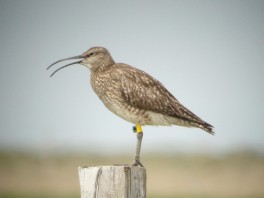
Whimbrel wearing a geolocator (Camilo Carneiro)
Marking birds is not without cost. Catching a bird to fit a ring, however light and however expertly applied, subjects the individual to extra risk. Perhaps the ring might get wool tangled around it for instance? Logic suggests that every extra device, from colour-rings through to a harness that carries a satellite tag, adds mass and potential problems. This paper focuses on geolocators – the half-way house between satellite tags and colour-rings, in terms of weight. I find it encouraging that so many scientists have combined in this review of the way that geolocators affect birds’ lives. By providing their data for analysis, they remind us that professional ornithologists have a shared concern for the birds that they work on. As people, they want to minimise the effects on individual birds and, as scientists, they need to reassure themselves that tagged individuals are providing data that are representative of other birds of the same species.
What are geolocators?
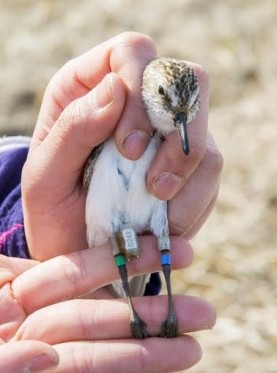
This Semipalmated Sandpiper carried a geolocator for two years (Emily Weiser)
Geolocators collect information on place and time. Unlike satellite tags, which can relay information from the bird to the scientist on a day-to-day basis, geolocators have to be deployed and then retrieved, so that data can be down-loaded. In the intervening period, these tiny devices record the time of dawn and dusk, information that can be decoded to reveal daily locations, apart from during the periods of spring and autumn equinoxes (when day length is virtually independent of latitude) and if there is heavy cloud. Geolocators are particularly useful for waders, as most of them live in very open environments (but less good for nocturnal species such as woodcock).
The data used in this paper relate to geolocators weighing between 0.8g and 2.0g, representing 0.1– 3.9 % of mean body mass of the species to which they were applied. They were attached to 16 species of migratory shorebirds, including five species with between 2 and 4 subspecies, making a total of 23 study taxa. The smallest species was only 26 grammes and the largest was just over a kilogramme. Birds were tagged at 23 breeding and eight nonbreeding sites, spread throughout the world.
Geolocators can be attached to harnesses and sit on the back of birds or, as in most cases studied here, attached to a ring or flag on a bird’s leg. The paper looks at the different effects of tags mounted in different ways.
Invaluable Data
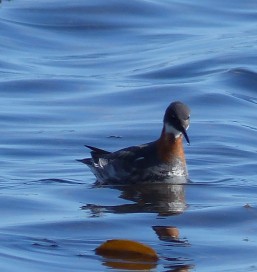 Many wader populations are in trouble. Of the eight curlew species, for instance, one or two species are probably extinct, three others are endangered, vulnerable and near-threatened and only three are not causing concern.
Many wader populations are in trouble. Of the eight curlew species, for instance, one or two species are probably extinct, three others are endangered, vulnerable and near-threatened and only three are not causing concern.
Establishing migratory routes and the timing of movements is a critical part of understanding the migration strategies of waders. The results collected from geolocators have important consequences for conservation and are truly fascinating. Who would have believed that Red-necked Phalaropes breeding in Shetland (north of Scotland and west of Norway) would migrate west and south to spend the winter on the surface of the Pacific Ocean between Galapagos and Ecuador? Geolocator tagging reveals Pacific migration of Red-necked Phalarope Phalaropus lobatus breeding in Scotland. Smith, M., Bolton, M., Okill, D.J., Summers, R.W., Ellis, P., Liechti, F. & Wilson, J.D. Ibis. DOI: 10.1111/ibi.12196
Waders operate at a truly global scale, with Bar-tailed Godwits making phenomenal journeys directly from Alaska to New Zealand. This species and others using the East Asian-Australasian flyway are causing major concerns for wader biologists, who have measured huge losses in populations wintering in Australia, New Zealand and south-east Asia. Ringing and colour-ringing had shown that birds fly north each spring to eastern Siberia and Alaska via the coast of eastern Asia – countries such as South Korea and China where there are major development pressures upon estuaries. Simultaneous declines in summer survival of three shorebird species signals a flyway at risk. Theunis Piersma,Tamar Lok, Ying Chen, Chris J Hassell, Hong-Yan Yang, Adrian Boyle, Matt Slaymaker, Ying-Chi Chan, David S Melville, Zheng-Wang Zhang, Zhijun Ma. Journal of Applied Ecology.
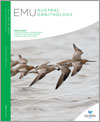 Identifying key staging sites, such as the northern end of the Sakhalin peninsular, was possible thanks to the deployment of geolocators, as shown in this paper. Movement patterns of Sanderling (Calidris alba) in the East Asian–Australasian Flyway and a comparison of methods for identification of crucial areas for conservation. Simeon Lisovski, Ken Gosbell, Maureen Christie, Bethany J. Hoye, Marcel Klaassen, Iain D. Stewart, Alice J. Taysom and Clive Minton. Emu. DOI 10.1071/MU15042
Identifying key staging sites, such as the northern end of the Sakhalin peninsular, was possible thanks to the deployment of geolocators, as shown in this paper. Movement patterns of Sanderling (Calidris alba) in the East Asian–Australasian Flyway and a comparison of methods for identification of crucial areas for conservation. Simeon Lisovski, Ken Gosbell, Maureen Christie, Bethany J. Hoye, Marcel Klaassen, Iain D. Stewart, Alice J. Taysom and Clive Minton. Emu. DOI 10.1071/MU15042
Using this information, conservation organisation and governments have started to work together to campaign for more sympathetic development of key areas. Conservation without borders – solutions to declines of migratory shorebirds in the East Asian–Australasian Flyway. Judit K. Szabo, Chi-Yeung Choi, Robert S. Clemens and Birgita Hansen. Emu. DOI 10.1071/MU15133
This is just one of many examples of the use of geolocators to fill gaps in migratory stories for waders. Geolocators are also being used to establish wintering areas for breeding species (e.g. Knot in South America) and to assess remotely whether individuals nest successfully. Using Geolocator data to reveal incubation periods and breeding biology in Red Knots Calidris canutus rufa. Burger J, Niles L J, Porter R R & A D Dey. Wader Study. 119(1): 26–36.
Conclusions
It is not possible to reproduce all of the results in the paper here, or to list all the caveats presented by the authors, but these are the salient points. Anyone considering using geolocators on waders/shorebirds will want to read the whole paper in detail.
- Importantly, no negative effects of geolocators were detected for most species of shorebirds – including some that migrate huge distances.
- For some small-bodied taxa (mean body mass ≤58 g), there were substantial negative effects. Geolocators reduced nest success, hatching rate, and/or return rate for two small-bodied species – Semipalmated Sandpipers and Arcticola Dunlin.
- Changing the way that a geolocator is mounted on the leg can have consequences in terms of return rates and damage to eggs. Simple changes, such as rounding the corners of flags may reduce problems.
- Studies of the same species in different areas produced different results, in terms of the impacts of geolocators.
- The findings suggest that guidelines for the relative mass of devices, as developed for backpack-style attachments, may be too liberal for leg-mounted tags. The graph presented in the paper suggests that negative effects may be detected when the tag and attachment together weigh more than 1.5% of body mass.
- It is not unusual for a wader to live for more than ten years; the studies that contribute to this paper are mostly of short duration and cannot assess long-term effects of tags.
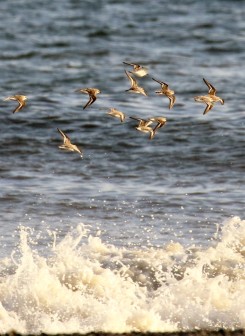
Tómas Gunnarsson
To learn more please read the paper: The effects of geolocators on hatching success, return rates, breeding movements, and change in body mass in 16 species of Arctic-breeding shorebirds. Emily L. Weiser, Richard B. Lanctot, Stephen C. Brown, José A. Alves, Phil F. Battley, Rebecca Bentzen, Joël Bêty, Mary Anne Bishop, Megan Boldenow, Loïc Bollache, Bruce Casler, Maureen Christie, Jonathan T. Coleman, Jesse R. Conklin, Willow B. English, H. River Gates, Olivier Gilg, Marie-Andrée Giroux, Ken Gosbell, Chris Hassell, Jim Helmericks, Andrew Johnson, Borgný Katrínardóttir, Kari Koivula, Eunbi Kwon, Jean-Francois Lamarre, Johannes Lang, David B. Lank, Nicolas Lecomte, Joe Liebezeit, Vanessa Loverti, Laura McKinnon, Clive Minton, David Mizrahi, Erica Nol, Veli-Matti Pakanen, Johanna Perz, Ron Porter, Jennie Rausch, Jeroen Reneerkens, Nelli Rönkä, Sarah Saalfeld, Nathan Senner, Benoît Sittler, Paul A. Smith, Kristine Sowl, Audrey Taylor, David H. Ward, Stephen Yezerinac and Brett K. Sandercock. Movement Ecology 20164:12. DOI: 10.1186/s40462-016-0077-6
Implications
I am sure that members of panels charged with the task of issuing permits to those engaged in migration research will find this study tremendously useful, especially as so much detail has been made freely available within the paper and in supplementary material. It is hugely encouraging that, for most species, there is no evidence that the costs to individuals outweigh the potential conservation benefits. Future decisions to deploy devices on small-bodied shorebirds will be made on a case-by-case basis, weighing the potential impacts on individuals and populations against the value of improved knowledge of migratory movements.
Additional information
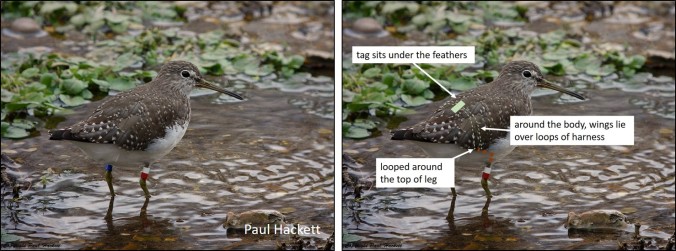 This later WaderTales blog, about Green Sandpipers, considers behavioural responses associated with wearing geolocators attached using a harness: Green Sandpipers and Geolocators.
This later WaderTales blog, about Green Sandpipers, considers behavioural responses associated with wearing geolocators attached using a harness: Green Sandpipers and Geolocators.
WaderTales blogs are written by Graham Appleton, to celebrate waders and wader research. Many of the articles are based on previously published papers, with the aim of making wader science available to a broader audience.
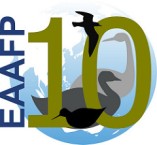

Pingback: Blog Birding #276 « ABA Blog
This page really has all the information and facts I wanted
about this subject and didn?t know who to ask.
LikeLiked by 1 person
Pingback: A Great summer for Iceland’s waders? | wadertales
Pingback: Well-travelled Ringed Plovers | wadertales
Pingback: Green Sandpipers and Geolocators | wadertales
Pingback: Leg-flags and nest success | wadertales
Pingback: Iceland to Africa, non-stop | wadertales
Pingback: Whimbrel: time to leave | wadertales
Pingback: Travel advice for Sanderling? | wadertales
Pingback: Migration blogs on WaderTales | wadertales
Pingback: Flagging up potential problems | wadertales
Pingback: Spoon-billed Sandpipers: Track and Trace | wadertales
Pingback: Dunlin: tales from the Baltic | wadertales